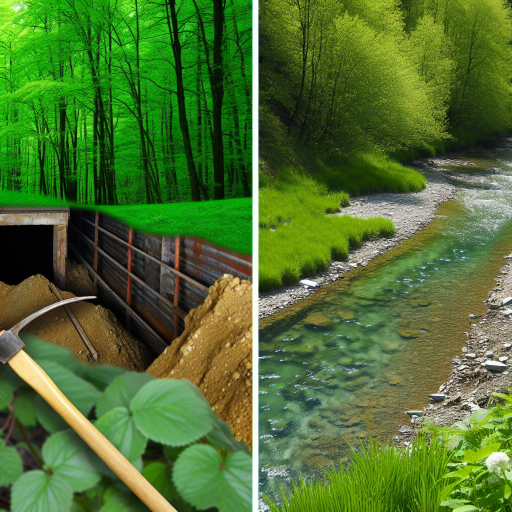Introduction:
The timber industry is a vital sector that involves the harvesting, processing, and distribution of wood products.
Lumberjacks play a crucial role in the timber industry as they are responsible for cutting down trees.
Importance of lumberjacks in the industry
Lumberjacks are essential because they provide the raw material needed for various wood products.
They ensure the sustainable management of forests by selectively cutting trees to maintain ecological balance.
Additionally, lumberjacks contribute to the economy by generating jobs and supporting local communities.
Their skills and expertise in handling and processing timber ensure high-quality wood products are produced.
Overall, lumberjacks are the backbone of the timber industry, playing a crucial role in its success.
History of Lumberjacks:
Lumberjacking can be traced back to ancient civilizations where trees were felled for construction.
The profession of lumberjacking evolved as demand for wood products increased over time.
Significant events in lumberjacking history include the industrial revolution and expansion of logging operations.
As early as ancient times, humans have been cutting down trees for various purposes such as construction, fuel, and more.
This practice, which eventually led to the profession of lumberjacking, has evolved significantly over the years.
Origins of Lumberjacking:
In ancient civilizations, trees were felled using primitive tools like axes and saws.
Lumberjacks were typically skilled individuals who could navigate dense forests and cut down trees efficiently.
The use of animals like oxen or horses to transport the logs was common in early lumberjacking operations.
During the early days of lumberjacking, the process was labor-intensive and required a great deal of skill and physical strength.
Lumberjacks often worked in remote areas, facing harsh weather conditions and rugged terrain.
Evolution of the Profession:
With advancements in technology, chainsaws and other mechanized tools revolutionized the lumber industry.
Logging camps and sawmills became more common, providing centralized locations for processing timber.
The introduction of logging trucks and railways improved transportation of logs from the forests to the mills.
Transform Your Career Today
Unlock a personalized career strategy that drives real results. Get tailored advice and a roadmap designed just for you.
Start NowAs technology advanced, the profession of lumberjacking saw significant changes.
Chainsaws replaced traditional hand tools, making the process faster and more efficient.
Logging camps and sawmills became essential components of the industry, streamlining the production process.
Significant Events in Lumberjacking History:
The industrial revolution brought about increased demand for lumber, leading to mass deforestation.
Conservation efforts and sustainable logging practices have emerged in response to environmental concerns.
Regulation of the timber industry by governments and organizations has helped ensure responsible logging practices.
Throughout history, there have been significant events that have shaped the lumber industry.
The industrial revolution marked a period of rapid expansion in logging operations, resulting in widespread deforestation.
In response to environmental concerns, conservation efforts and sustainable logging practices have become more prevalent.
Government regulations and oversight by organizations have played a crucial role in promoting responsible forestry practices and protecting natural resources.
Lumberjack Responsibilities in the Timber Industry
Lumberjacks play a crucial role in the timber industry.
They carry out various responsibilities to ensure smooth logging activities.
Here are some key responsibilities of lumberjacks:
Cutting and Harvesting Trees
Lumberjacks primarily fell trees in designated logging areas.
They use chainsaws or other cutting tools to carefully bring down trees.
This process adheres to safety protocols and requires skill and precision.
They aim to avoid accidents and minimize damage to surrounding trees.
Once the trees are felled, lumberjacks must strip them of branches.
They prepare the trees for transportation by cutting them into logs.
Showcase Your Business Today
Reach thousands of readers actively exploring professional services. Publish your business profile and grow your audience now.
Publish NowSorting and Transporting Logs
Lumberjacks sort logs based on size, quality, and type of wood.
This sorting ensures that logs meet the required specifications.
Once sorted, they load logs onto trucks or other transport vehicles.
Lumberjacks carefully secure logs to prevent shifting during transport.
Maintaining and Repairing Equipment
Lumberjacks work with a variety of tools and equipment.
They regularly inspect, maintain, and repair these tools.
Regular maintenance prevents equipment failures and accidents.
Lumberjacks must be trained in proper tool usage and safety procedures.
Uncover the Details: How to Become a Certified Pipelayer: A Step-by-Step Guide
Challenges Faced by Lumberjacks:
Lumberjacks play a crucial role in the timber industry.
However, their job comes with a myriad of challenges.
- Dangerous work environment
- Long hours and physical strain
- Seasonal work and economic instability
Dangerous Work Environment:
Working as a lumberjack involves facing various hazards regularly.
The job entails cutting down trees and working in rugged terrain.
This exposure can lead to risks such as falling trees, branches, and rough weather.
Lumberjacks must be vigilant and follow strict safety protocols.
Long Hours and Physical Strain:
Lumberjacks typically work long hours, starting early and ending after sundown.
The work demands include lifting heavy equipment and operating machinery.
A high level of physical fitness is necessary to endure these conditions.
Seasonal Work and Economic Instability:
The timber industry is influenced by seasonal fluctuations.
Peak work periods occur during the warmer months when logging is most active.
In winter, work may slow or halt, affecting steady employment.
This seasonal aspect can lead to economic instability for lumberjacks.
Such challenges make planning for the future difficult.
See Related Content: Groundskeeping for Commercial vs. Residential Properties
Training and Skills Required
Lumberjacks typically require a high school diploma or GED.
Some employers may also prefer candidates with specialized training in forestry or related fields.
Certification from organizations like the Forest Stewardship Council can also enhance job prospects.
Lumberjacks are trained in the use of various tools and equipment essential for the job.
This includes chainsaws, axes, logging trucks, and other machinery used for cutting, hauling, and processing timber.
Working as a lumberjack involves inherent risks, so knowledge of safety protocols and adherence to regulations are crucial.
Lumberjacks receive training on proper techniques for felling trees, operating machinery, and handling logs to minimize the risk of accidents and injuries.
In addition to technical skills, lumberjacks must also possess physical fitness and endurance.
They perform strenuous tasks such as carrying heavy logs, hiking in rugged terrain, and working in varying weather conditions.
Strong communication and teamwork skills are also important, as lumberjacks often work in crews to efficiently harvest timber.
The training and skills required for lumberjacks involve a combination of formal education, hands-on experience, and continuous learning.
This helps maintain safety standards, enhance productivity, and contribute to sustainable forest management practices.
Uncover the Details: Career Path: Becoming a Successful Drywall Installer
Environmental Impact of Lumberjacks
Lumberjacks have a significant impact on the environment, both positive and negative.
It is important for lumber companies to prioritize sustainable practices to minimize the negative effects on the environment.
Deforestation is a major issue caused by logging activities which can lead to habitat destruction.
Showcase Your Business Today
Reach thousands of readers actively exploring professional services. Publish your business profile and grow your audience now.
Publish NowDeforestation concerns arise when large areas of forests are cleared for logging purposes.
This results in loss of biodiversity and destruction of habitats for wildlife.
Lumberjacks must be conscious of the environmental impact of their activities.
Working towards minimizing deforestation is essential.
Sustainable logging practices involve carefully planning the logging process.
This planning ensures the long-term health of the forest.
Selective cutting is one practice where only a certain number of trees are harvested.
This method leaves the rest to continue growing.
Replanting trees is also essential to replenish the forest.
This practice helps maintain biodiversity.
Lumberjacks play a crucial role in conserving forests.
They do this by selectively harvesting trees and replanting them.
By following sustainable practices, lumberjacks contribute to the preservation of ecosystems.
They also help protect wildlife habitats.
It is crucial for lumber companies to collaborate with environmental organizations.
Working with government agencies ensures responsible logging activities.
This includes monitoring forest health and implementing safeguards.
Protection of endangered species is also vital.
Additionally, promoting conservation education among workers is important.
By prioritizing sustainability, lumberjacks can help preserve natural resources.
This preservation is essential for future generations.
Delve into the Subject: How to Create Accent Walls with Bold Colors

Technology in Lumberjacking:
As the timber industry continues to evolve, technology plays a crucial role in improving the efficiency, safety, and sustainability of lumberjacking operations.
Modern tools and equipment have revolutionized the way lumberjacks approach their work, resulting in significant advancements in the sector.
Modern Tools and Equipment:
- Chainsaws: Gone are the days of manual sawing, with chainsaws now being the go-to tool for felling trees and cutting logs swiftly.
- Portable Mills: These machines enable lumberjacks to process timber on-site, reducing transportation costs and increasing productivity.
- Logging Trucks: Specialized vehicles equipped to transport timber from the forest to processing facilities efficiently.
- Drones: Used for aerial surveys to assess tree health, monitor logging activities, and plan operations strategically.
Automation and Efficiency:
- Automated Felling Machines: These advanced tools can fell and delimb trees with precision, reducing manual labor and increasing safety.
- GPS Technology: Lumberjacks now rely on GPS systems to navigate forests, mark tree locations, and plan harvesting routes effectively.
- Log Grapples: Mechanized grapples can lift and move heavy logs with ease, improving speed and efficiency in timber handling.
- Data Analytics: Technology aids in analyzing forest data to make informed decisions on harvesting techniques and resource management.
Impact on Traditional Lumberjack Practices:
While technology has undoubtedly enhanced the timber industry, it has also brought about changes in traditional lumberjack practices.
- Increased Productivity: Modern tools and equipment have significantly boosted productivity levels, allowing lumberjacks to accomplish more in less time.
- Improved Safety: Automation has mitigated risks associated with manual labor, ensuring a safer working environment for lumberjacks.
- Sustainability: Technology enables more sustainable harvesting practices, promoting reforestation and responsible timber management.
- Skills Adaptation: Lumberjacks now need to be proficient in operating high-tech machinery, requiring additional training and skill development.
Technology in lumberjacking has ushered in a new era of innovation and efficiency in the timber industry.
By embracing modern tools and equipment, lumberjacks can navigate forests with precision, harvest timber sustainably, and contribute to a more progressive and eco-friendly future.
Contribution to the Timber Industry
Lumberjacks play a pivotal role in the timber industry by harvesting trees to provide raw materials for various wood products.
This process involves cutting down trees, processing logs, and transporting timber to sawmills for further production.
The work of lumberjacks ensures a steady supply of wood for construction, furniture manufacturing, paper production, and other industries that rely on timber as a primary material.
Without their contribution, these sectors would struggle to meet the demand for wood products.
Employment Opportunities in Rural Areas
One of the key benefits of having a thriving timber industry is the creation of employment opportunities in rural areas where logging operations take place.
Lumberjacks often work in remote forested regions, providing jobs for local residents who may not have access to other industries.
By offering stable employment and income for workers in these areas, lumberjacks help support rural economies and communities.
Their presence helps prevent migration to urban centers in search of work, thus contributing to the sustainable development of rural regions.
Economic Benefits for Local Communities
The economic benefits of having lumberjacks in local communities go beyond job creation.
As lumberjacks harvest trees and process timber, they generate revenue for the region through the sale of wood products and services.
Local businesses that supply equipment, tools, and other resources to lumberjacks also benefit from their presence, stimulating economic growth in the area.
Additionally, logging operations may pay taxes and support infrastructure development, further contributing to the local economy.
Lumberjack’s Role in the Timber Industry
Lumberjacks play a crucial role in the timber industry by harvesting trees for various purposes such as construction, furniture, and paper production.
Showcase Your Business Today
Reach thousands of readers actively exploring professional services. Publish your business profile and grow your audience now.
Publish NowWithout them, the supply chain of timber would be severely disrupted, impacting various industries and economies.
We must acknowledge the hard work and dedication of lumberjacks, who often work in challenging conditions, risking their lives to ensure a steady supply of timber.
Their contribution cannot be overstated, and they deserve recognition for their efforts.
Looking ahead, the future prospects for the profession of lumberjacks seem promising.
As long as there is a demand for timber products, there will always be a need for skilled lumberjacks to harvest trees sustainably and efficiently.
With advancements in technology and training, the profession is likely to evolve and become more efficient in the coming years.
Additional Resources
Forest Contracting Businesses in the US Southwest: Current Profile …
What is it like to be a lumberjack? – Quora
[E-Books for Sale]
The Big Book of 500 High-Paying Jobs in America: Unlock Your Earning Potential
$19.99 • 500 High-Paying Jobs • 330 pages
Explore 500 high-paying jobs in America and learn how to boost your career, earn more, and achieve success!
See All 500 High-Paying Jobs of this E-Book
1001 Professions Without a Degree: High-Paying American Jobs You Can Start Now
$19.99 • 1001 Professions Without a Degree • 174 pages
Discover 1001 high-paying jobs without a degree! Unlock career tips, skills, and success strategies for just $19.99!




